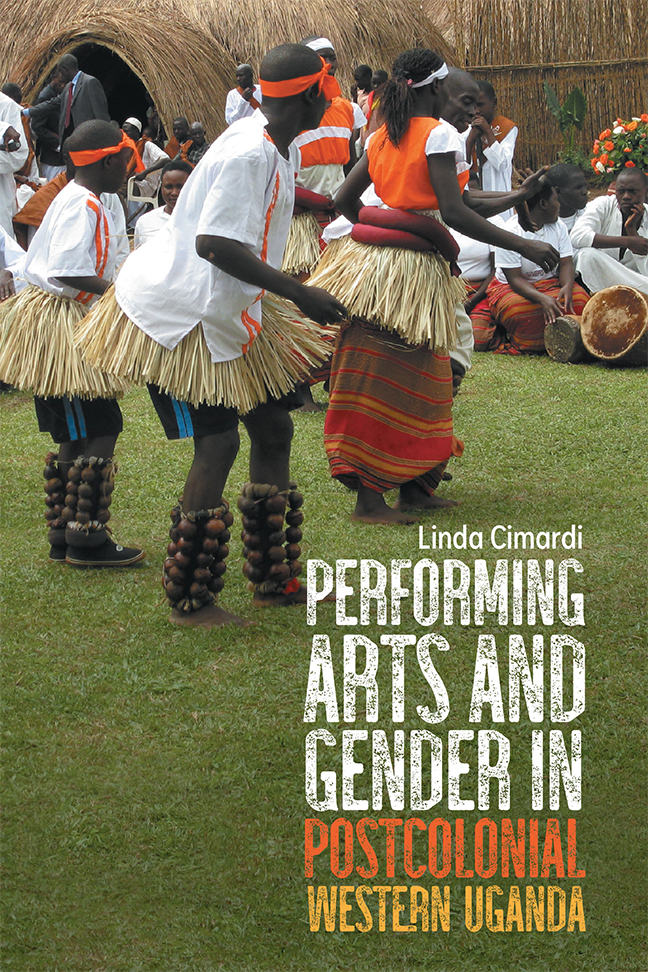Book contents
- Frontmatter
- Contents
- List of Illustrations
- Foreword
- Acknowledgments
- Note on Language
- Note on the Musical Examples
- Note on Online Audio and Video Material
- Prelude: Encountering Local Culture in Western Uganda
- Introduction: Approaching Gender and Performing Arts in Bunyoro and Tooro
- One “Traditional Dance Preserves Culture and Shows People How to Behave”: Runyege, MDD, and Gender
- Two Singing Marriage, Runyege, and Labor
- Three “Women Aren't Supposed To”: Instrument Playing in the Past and Today
- Four Shaking the Hips, Stamping the Feet: The Runyege Dance
- Five Narrating and Representing Local Culture: Theater in Songs and Dances
- Six Trans-Performing and Morality in Cultural Groups
- Postlude: Gendering Culture
- I Glossary of Terms in Runyoro-Rutooro
- II Historical Recordings from Bunyoro and Tooro
- Author's Interviews
- References
- Index
Postlude: Gendering Culture
Published online by Cambridge University Press: 17 December 2023
- Frontmatter
- Contents
- List of Illustrations
- Foreword
- Acknowledgments
- Note on Language
- Note on the Musical Examples
- Note on Online Audio and Video Material
- Prelude: Encountering Local Culture in Western Uganda
- Introduction: Approaching Gender and Performing Arts in Bunyoro and Tooro
- One “Traditional Dance Preserves Culture and Shows People How to Behave”: Runyege, MDD, and Gender
- Two Singing Marriage, Runyege, and Labor
- Three “Women Aren't Supposed To”: Instrument Playing in the Past and Today
- Four Shaking the Hips, Stamping the Feet: The Runyege Dance
- Five Narrating and Representing Local Culture: Theater in Songs and Dances
- Six Trans-Performing and Morality in Cultural Groups
- Postlude: Gendering Culture
- I Glossary of Terms in Runyoro-Rutooro
- II Historical Recordings from Bunyoro and Tooro
- Author's Interviews
- References
- Index
Summary
While I am writing these pages, the Covid-19 pandemic has been going on for almost three years. As it happened globally, the lockdowns imposed by the Ugandan government in 2020 and 2021 seriously impacted social life as well as the economy. In the cities and towns urban dwellers found themselves in the impossible situation of needing to earn income and purchase food, while in rural areas both food and social relations were less affected because of scattered family-based residents, cultivation of gardens, and local economy. Schools in Uganda remained closed for more than one year with deplorable consequences for a whole generation of students, such as a high school dropout rate and early pregnancies. In addition, like almost everywhere around the globe, cultural life and, with it, live music and dance performances were initially reduced and then prohibited during the lockdowns. Several songs about Covid-19 prevention and sensitization were produced and disseminated through the media, especially at the beginning of the emergency in 2020. Whereas in the past the reaction to HIV/AIDS stimulated the establishment of cultural groups and the production of live performances dealing with this topic, the Covid-19 situation severely restricted live performances of traditional arts, and therefore blocked a space for social and individual expression. It is, however, too early to evaluate the medium- and long-term impact of the Covid-19 pandemic on traditional performing arts, and this can be a fruitful topic for further investigations.
Throughout this book, I have discussed the deep and manifold interconnectedness of gender and traditional performing arts in western Uganda through their complex relations within the local discourses, in terms of representation and embodiment. I have analyzed how the various components of traditional MDD are molded by the hegemonic gender binary in content, structure, and practice. I have traced the continuities between the performance of traditional repertoires in the past and in the present and highlighted the places where the new has split from the old, reconstructed through historical sources and recordings, as well as from the recollections of elders. I noted how alternative genders have been flattened during the colonial era into what is today understood as the traditional gender binary, essentially represented by the “Domestic Virtue model” for women and its counterpart for men, which was then absorbed by the postcolonial society.
- Type
- Chapter
- Information
- Performing Arts and Gender in Postcolonial Western Uganda , pp. 221 - 226Publisher: Boydell & BrewerPrint publication year: 2023

